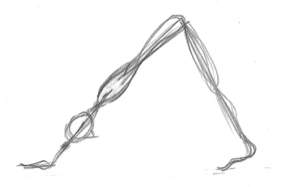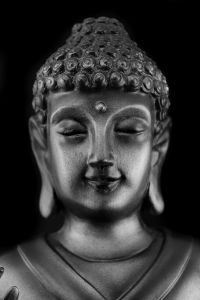 by Joan Arnold
by Joan Arnold
Yoga Alert
Women! Beware of yoga! So said a November, 2013 article in the New York Times by William Broad, a science writer whose provocative articles have challenged America's current love affair with yoga.* He cited serious injuries women have sustained in extreme yoga postures, concluding that yoga's emphasis on flexibility causes severe hip joint strain among women.
Speaking as a yoga teacher and a middle-aged woman with hip joints, I know that, in the practice and teaching of yoga, generalities don't help. Some women have loose joints, and some don’t. Some yoga forms put practitioners into exaggerated poses, others don’t. As a teacher of the Alexander Technique, I help people – yogic and otherwise – recover from hip replacements by helping them unravel habits developed before or after surgery, and helping them learn how to move well in their daily lives. For prevention or rehabilitation, the most important focus is you how you move. How you walk and sit or perform yoga postures will create strain or harmony in that crucial center of the body. It’s all in how you do it.
Use or Genetics?
Any movement teacher worth his or her salt should know the pitfalls of stiffness and hyper-mobility. Some of our students are tightly strung, others loosely strung. Some are women and some are men.
One aspect of flexibility comes from muscle – muscle fibers’ resting length and the quality of the connective tissue that surrounds each fiber and muscle group. When we stretch to become more flexible, the best approach is to do so gently, increasing that resting length gradually. Another aspect of flexibility is inherited, determined by the length of our ligaments, the connectors binding bone to bone that stabilize the skeleton. Once a ligament is stretched, it stays that way. That's why we need to be clear about what we're stretching and why. When you stretch, your primary sensation should be in the muscle, not in the joint.
Those we call double-jointed are born with longer ligaments. The advantage is that they are naturally flexible, and yoga’s full range of postures come more easily to them. The disadvantage is that their joints are less stable. They need to avoid hanging on their joints – something that can feel good and stretchy – and learn how to more fully engage their muscles to stabilize this genetic laxity. I have one yoga student, a builder who swings a hammer, lifts and climbs all day long, who is hyper-mobile. I coach him to engage his muscles, not to hang in down dog but to lift up, fully engage the shoulders to spare his joints from the over-extension that, to him, comes naturally.
Those with shorter ligaments have the benefit of greater joint stability. Though they’d like to be looser, initially they may hate stretching. In the current culture of yoga, dramatic flexibility is over-emphasized, as is performance over process. These folks may envy those flexier types, but it’s best when they work with their own body gradually, learning how to release muscles and fascia, to make fuller joint movement available.
Do you know your body type? Your muscles may be tight or loose, but it’s good to know whether your joints—your ligaments—are close-knit or loose. A good teacher or physical therapist can tell you, but you can test yourself. Extend one arm out in front of you. If your elbow goes beyond straight, so it rises above the forearm, you’re on the flexible side. If it’s hard to straighten your arm fully, your ligaments probably tend to be short.
Structure & Habit

I’ve had beautiful, accomplished yoginis come to my class, dropping into their shoulder joints in down dog – adho mukha svanasana – or too low in the forward lunge Anjaneyasana, pushing down into the ribs and waist, putting pressure on the hip joints and lower back. In down dog, I help them allow their ribs to come back and up, to spare their shoulders and hips. In lunge, I teach them to come up from the bottom of the pelvis rather than hang on those available joints. Using the Alexander Technique’s idea of lightness at the top of the spine helps them engage their torso’s natural buoyancy. With a gentle hands-on suggestion, I encourage them to stop pushing down and guide the pelvis to tilt up and away from the front leg. Rather than exerting repetitive pressure and misaligning the upper thigh (the femur in the socket of the acetabulum, if you want to get technical), they can spare those delicate feminine hip joints. The result is freedom and lightness as they breathe more fully and build strength with balance.

As teachers, we can determine how a student's habits and genetics interact and what each one needs to learn. Though awareness is considered a priority in yoga, "listening to your own body” may mean that you indulge your preferences and perpetuate unconscious habits that do not further your practice. An insightful teacher can suggest shifts that initially may feel unfamiliar or wrong, but can lead you toward a deeper understanding of your body’s unique needs and a more intelligent practice of the subtle, complex art we call yoga.
* The first, an excerpt from Broad’s book "The Science of Yoga," was a sensational New York Times magazine cover story in January, 2012, entitled How Yoga Can Wreck Your Body. That piece highlighted the prevalence and seriousness of yoga injuries, and has sparked an ongoing and worthy conversation. Here are two among many responses:
"How Yoga Can Free Your Body" by Joan Arnold
"Does Yoga Kill?" by Timothy McCall
return to top
Drawings ©2013 by Joan Arnold, used with kind permission
[author] [author_image timthumb='on']http://www.acatnyc.org/main/wp-content/uploads/2014/05/Joan.Arnold.png[/author_image] [author_info]JOAN ARNOLD has been a movement educator for over 30 years, teaching dance, exercise, yoga and Alexander Technique. She has a private practice in NYC, Brooklyn and the Hudson Valley and has been quoted as an expert in Fit Yoga, O magazine and Timothy McCall’s 2007 book, Yoga as Medicine. Her articles on health, education and bodywork have appeared in national magazines and online in Elephant Journal. Joan teaches at Jaya Yoga Center in Park Slope, Brooklyn. In July 2014, she returns to Kripalu Center for Yoga & Health to reprise her week-long workshop on Yoga & the Alexander Technique. [/author_info] [/author]


 by John Austin
There have been
by John Austin
There have been 

